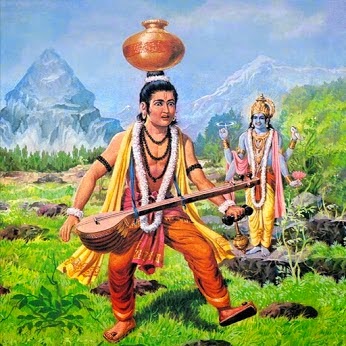

Also read an inspiring conversation between Yudhistra Maharaj and Yaksha:
http://krishnaseva.blogspot.com/2014/06/yudhistra-and-yaksha-story-in-english.html


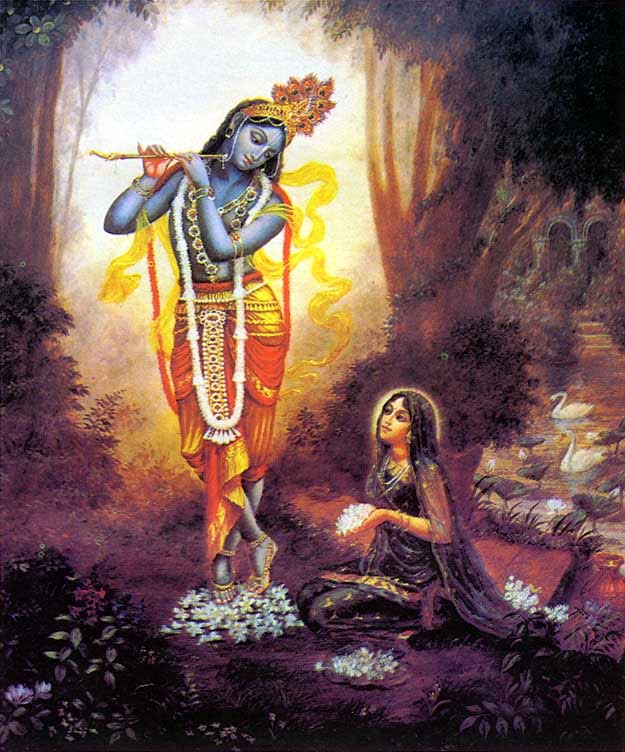
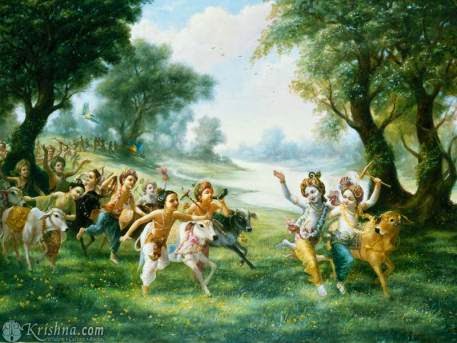
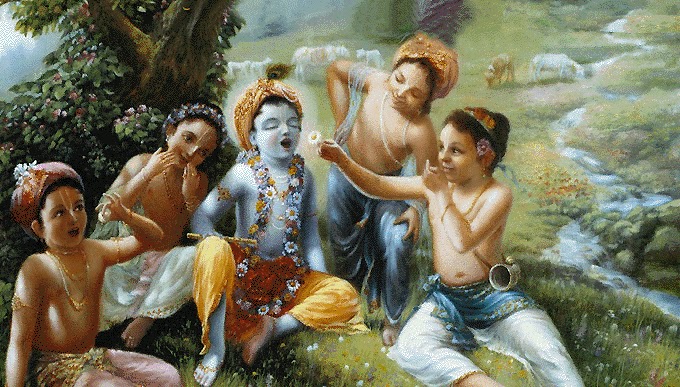
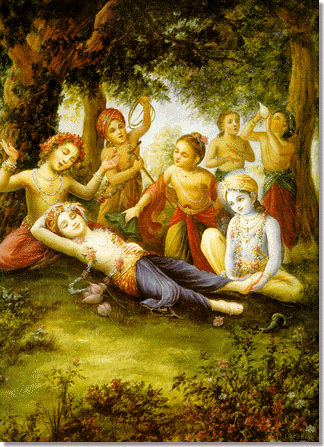

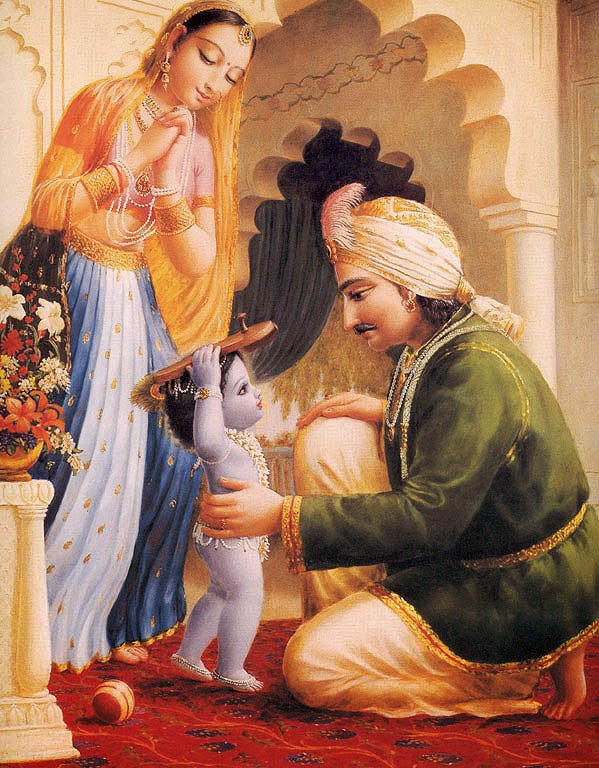
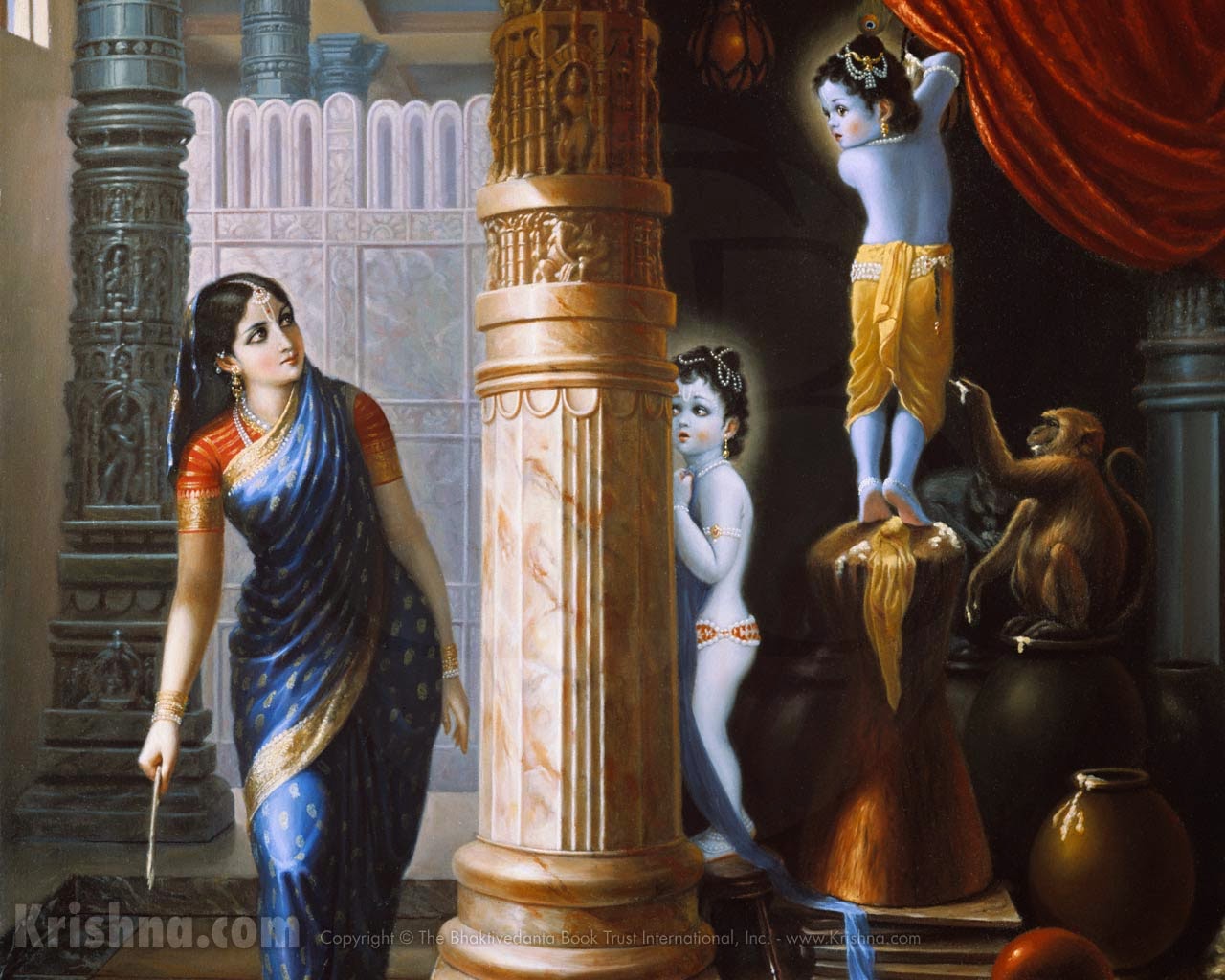
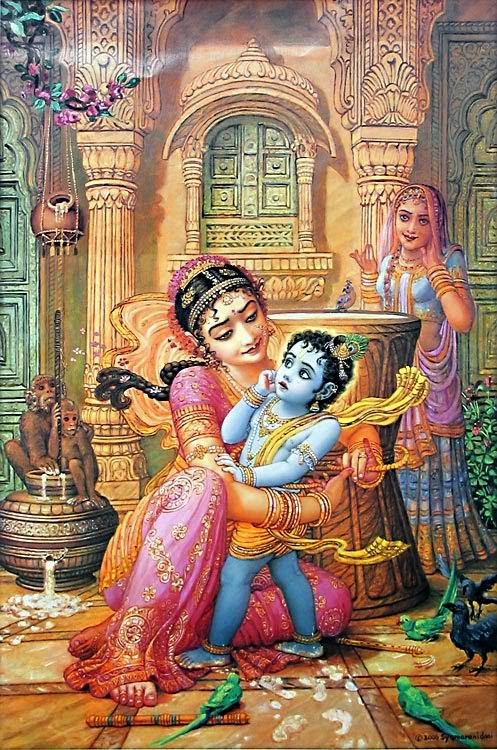
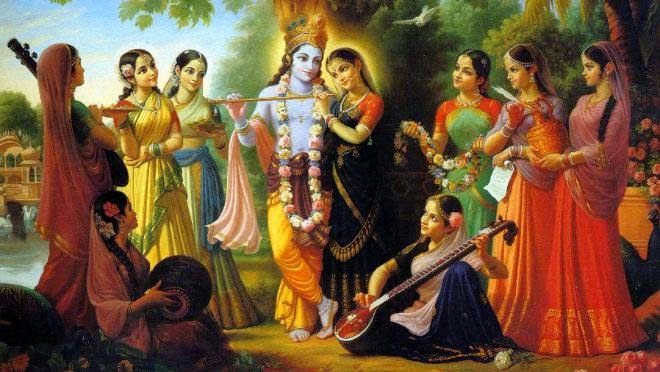
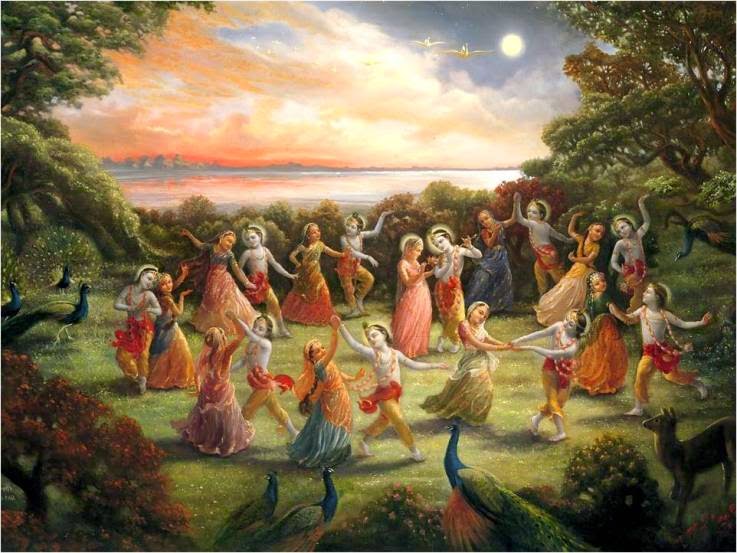
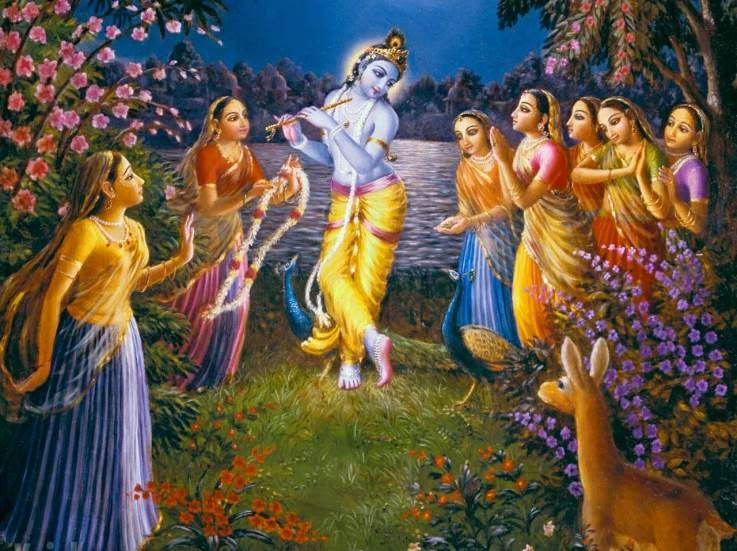
Source: http://krishnaseva.blogspot.in/
After offering my respectful obeisances unto the Lord of Lords, Who is the spiritual master of the entire universe, I will now narrate 108 holy names of Lord Chaitanya, the great soul.
Gaurāṅga sustains the universe, is victorious over the influence of mundane anger, and He assumes the illusory form of a human. He is bereft of fradulent behavior, is the foremost of cheaters, appears in the best of lands and is the ultimate brāhmaṇa.
Gaurāṅga is the dearest son of Jagannātha Miśra, Gaurāṅga is the devotee of His father, and He has great mental power. He is the beloved husband of the Goddess of Fortune, the son of mother Śacī, the bestower of ecstatic loving devotion, and He is very affectionate to His devotees.
Gaurāṅga is dear to the twice-initiated brāhmaṇas, He is the best among the brāhmaṇas, and He is the hero of the devotee’s life and soul. He worships the brāhmaṇas. He is peaceful and saintly. He is very dear to Śrīvāsa Paṇḍita, and He is the supreme controller.
His complexion is like molten gold, His neck is like a lion’s, His arms are very muscular. He wears yellow cloth [as householder] and red cloth as a sannyāsī. He exhibits a six-armed form and also a four-armed form.
Gaurāṅga exhibits a two-armed form, holds the mace, discus, lotus, and He is sinless. He holds the pāñcajanya conch shell, the bow, the flute, and is the foremost of the demigods.
Gaurāṅga is the Lord of the lotus-eyed Lakṣmī. He is beloved to all living beings. He is the abode of cowherding pastimes and is supremely youthful. He likes to wear sapphires, silver necklaces, and is adorned with the kaustubha gem.
Gaurāṅga is decorated with the mark of Śrīvatsa and His form is embellished with many brilliant jewels. He has lotus-petal-shaped eyes. His majesty is enhanced by sapphire earrings. He sometimes enacts the pastimes of Lord Śiva, and He is very dear to His spiritual master.
Gaurāṅga is aware of the attributes of His own holy names. He imparts teachings about the holy names. He is dear even to the lowest of outcastes. His character is totally immaculate. He is engaged in the welfare of all living beings.
Gaurāṅga is the younger brother of Viśvarūpa. He incarnated during dusk. He wants to cool the burning sufferings of living beings. His compassion is limitless. He is very secretive. He preaches devotion unto the true self.
Gaurāṅga is absorbed in the greatest bliss. He behaves as a dramatic actor, and is fond of dancing, singing, and chanting holy names. He is a learned scholar and poet. He is dear to those who are suffering. He is meticulously clean and spotlessly pure. He confers ecstatic loving emotions. He is intimate with the great devotees.
Gaurāṅga’s divine lotus feet are worshiped by Lord Indra and all the rulers of various heavenly planets. He is the crest-jewel of renunciates. He is the all-attractive Supreme Personality of Godhead. He is the purifier of the renounced order.
Gaurāṅga is the all-attractive living force of all creation. He carries the staff of the renounced order, and also abandons it. He is dear to Śrī Nityānanda Prabhu, the divine madman. He shows His six-armed form to Nityānanda.
Gaurāṅga gives perfection to His devotee Mukunda. He behaves with meek and humble mannerisms. He gives nectar to his devotee Vāsudeva, the leper. He is the Lord of the life of Gadādhara Paṇḍita. He removes the distress of His devotees. He bestows ultimate shelter to His devotees.
Gaurāṅga is dear to those who possess nothing. He is the life and soul of all creation. He accepts only the good qualities of others. He is victorious over the influence of the material senses. He is blind to the faults of others. He has a pleasant face and is supremely sweet. He is very precious to behold.
Gaurāṅga delivers Mahārāja Pratāparudra from obstacles. He is the beloved of Rāmānanda Rāya. He is the spiritual master of every living being. He is endowed with limitless good qualities. He is the sole purifier of all places of pilgrimage.
Gaurāṅga is the Lord of the anxiety-free spiritual world, and of all material planets. He assumes different forms according to the desires of His devotees. He is the supreme shelter for all living beings. He is the greatest performer of yoga. He imparts intellectual knowledge of devotion. He is the Lord and Master of all.
Gaurāṅga’s words emit showers of pure nectar. He is the savior of the earth. He speaks truthfully. He can endure all forms of misery. He delights the people of Orissa. He embodies the form of all universal nectar.
It is recommended that upon rising in the morning, one faithfully approach and recite this transcendental sin-destroying prayer to Śrī Caitanya Mahāprabhu, the great soul. One who does will feel the awakening of ecstatic loving devotion unto Lord Hari; of this there is no doubt.
1. Panihatti Chida Dahi Festival
http://krishnaseva.blogspot.in/2015/06/panihatti-chida-dahi-festival.html
2. Importance of Vaishnav Tilaka and how to wear it
http://krishnaseva.blogspot.in/2015/04/importance-of-vaishnav-tilaka-and-how.html
Source of this post: http://krishnaseva.blogspot.in/2015/06/panihatti-chida-dahi-festival.html
(you can find other good posts in that blog)

Panihatti is a town located on the banks of the Ganges, ten miles north of Kolkata. It is the site of many wonderful spiritual pastimes of Sri Chaitanya Mahaprabhu and His close associates. This pastime is about how the devotees pleased Lord Chaitanya and how He reciprocated in a pleasing festival called Panihatti Chida Dahi mahotsav.
The tree under which this pastime of the Lord took place Srila Raghunatha Das Gosvami was previously a householder and wanted to join the personal association and service of Lord Chaitanya Mahaprabhu at Jagannatha Puri. However, his father prevented Raghunatha dasa from doing so.

After several failed attempts, Raghunatha dasa heard that Lord Nityananda Prabhu had arrived at Panihati. In order to receive the Lord’s causeless mercy, Raghunatha dasa went to take His darshana. When Lord Nityananda saw Raghunatha dasa, He ordered him to prepare and serve all of His associates with chida dahi - flat rice mixed with yoghurt.
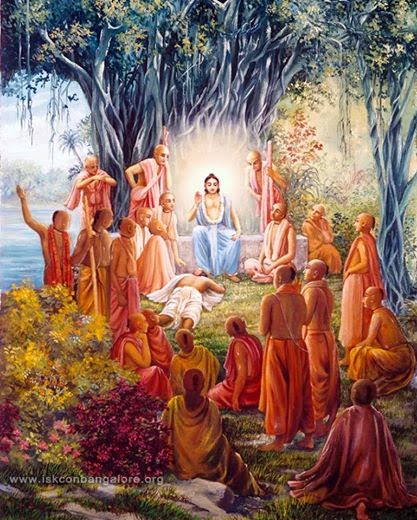
In order to please the Lord, Raghunatha dasa immediately carried out His order by preparing and distributing large quantities of chida-dahi to all the devotees as well as hundreds of others who had arrived on the spot upon hearing that a festival was on at Panihati.
Finally, Lord Nityananda blessed, and ordered His associates to bless, Raghunatha dasa, that he will be successful in attaining the personal association and service of Lord Chaitanya Mahaprabhu.

Even to this day many devotees from Mayapur and Kolkata assemble and conduct kirtanas and massive prasadam distribution to the thousands of pilgrims who arrive for the festival. Special pandals are erected in Panihati during this occasion.
Read post on Guru’s Love to his Disciple:
http://krishnaseva.blogspot.com/2014/06/gurus-love-to-his-disciple-krishna-and.html
Read post on glorification of 10 incarnation of Lord:
http://krishnaseva.blogspot.in/2015/05/sri-dasavatara-stotra-prayer-glorifying.html
When Krishna came to planet earth, Shiva goes to Gokul for a glimpse of child Krishna (just like he went to Ayodhya when Ramji took incarnation).
Once Shiva wished also see the manifestation Shri Krishna in the form of small child. Lord Shiva arrived in Gokul and reached at the gate of Nanda’s home.
A maid came out of home and said “These alms have been sent by Yashoda Ji, please accept these and give your blessings to the child”. Shiva said “I won’t accept anything. I don’t want anything except that I want to see little Krishna”. The maid informs Yashoda Ji about this. Meanwhile Shiva sings sings outside... “O Mother! I want to see the face of your little child. In your cradle lies the supreme ruler of the universe. Show me his face O Mother!”
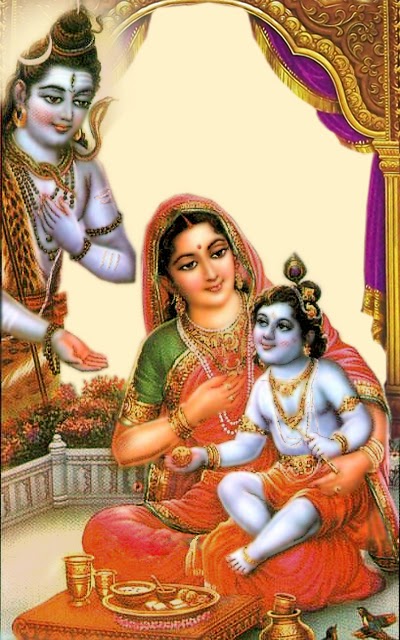
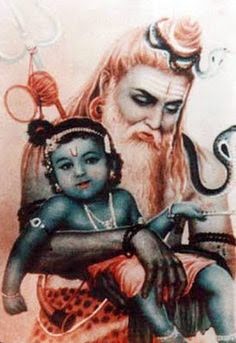
Also read story about how Shri Krishna liberated Demon Shatkasur:
Source: http://krishnaseva.blogspot.in/2014/09/shri-krishna-liberated-demon-shatkasur.html
To celebrate Krishna's turning over in the bed, Yashoda organised festivities and performed ceremonial ablutions. After the function was over, Yashoda was busy attending to the guests. She placed Krishna under a cart outside the house and put him to sleep. This cart was a ghost named Shaktasur.
Mother Yashoda carried on with zeal honouring the people of Vraja who had gathered there. She did not notice the cries of Krishna from outside. Being a ghost, Shaktasur had no gross body. Ghostly beings try to enter into another body to haunt people and create havoc in the world. Shaktasur especially wanted to kill Krishna. He took the opportunity and entered into the cart. Knowing this well, Krishna tossed up his feet and hit the cart, which turned upside down. All the vessels, containing various delicious substances, were crushed under the impact, its wheels and axle tree inverted and its pole shattered. Krishna destroyed the cart and also liberated Shaktasur.
The womenfolk along with Yashoda and Nanda rushed to the spot wondering how the cart could actually collapse by itself. Boys who were playing there, told the wondering cowherds that Krishna had actually knocked it down with his foot. Those cowherds however do not believe, assuming it to be a mere talk of children. They did not know the strength of that baby boy Krishna.
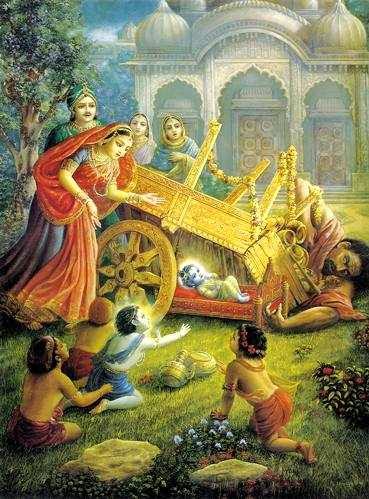
Who Shatkasur was & how he got a chance to attain liberation by touch of feet of supreme Lord Krishna:
The demon Hiranyaksha (who was slain by Varaha) had a son, Utkachh, who was strong and powerful. Once he crushed the trees of the hermitage of the sage Lomasha. Lomasha cursed him to remain disembodied forthwith. He felt that his physical sheath was about to fall off like a slough. He fell prostrate at the feet of the sage and sought forgiveness. The sage blessed him that he would be liberated by the touch of the feet of Lord Krishna. It was Utkachh who had entered the cart in Nanda's residence in the disembodied state and was liberated by Krishna.
Source: http://krishnaseva.blogspot.in/2014/09/salvation-of-demon-trinavarta-by-lord.html
When Krishna's maternal uncle Kansa came to know that Baby Krishna also killed Shatkasur. Then he got very angry and called Trinavarta to execute the task of killing Baby Krishna. Kansa made Trinavarta aware of the powers of Little Krishna. Trinavarta assured Kansa that he has ha magnificent power of blowing away everything and he will surely blow away Krishna and will through him from the height that will finally kill him.
Kansa sent the whirlwind-demon Trinavarta to finish off Lord Krishna. At the same time, and another function was observed by Yashoda and Nanda Maharaja (King Nanda): Krishna's first birthday. They arranged for Krishna's birthday ceremony. Lord Krishna, who was carried by his mother Yashoda in her lap, had come to know of this through his divine powers about new plan of Kansa and made himself heavy on her lap. He wanted to support the intent of Trinavarta just so that he could slay the wicked demon.
Yashoda had to finally put him down on the floor, finding him very heavy. She left him and went away to do some housework. Taking both the opportunity and the form of a powerful tornado, Because of this, everyone's eyes became covered within a few moments, and the whole area of Vrindavan became densely dark so that no one could see himself or anyone else. During this great catastrophe, mother Yashoda could not see her baby, who was taken away by the whirlwind, and she began to cry very piteously. She fell down on the ground exactly like a cow who has just lost her calf. When mother Yashoda was so piteously crying, all the cowherd women immediately came and began to look for the baby, but they were disappointed and could not find Him.
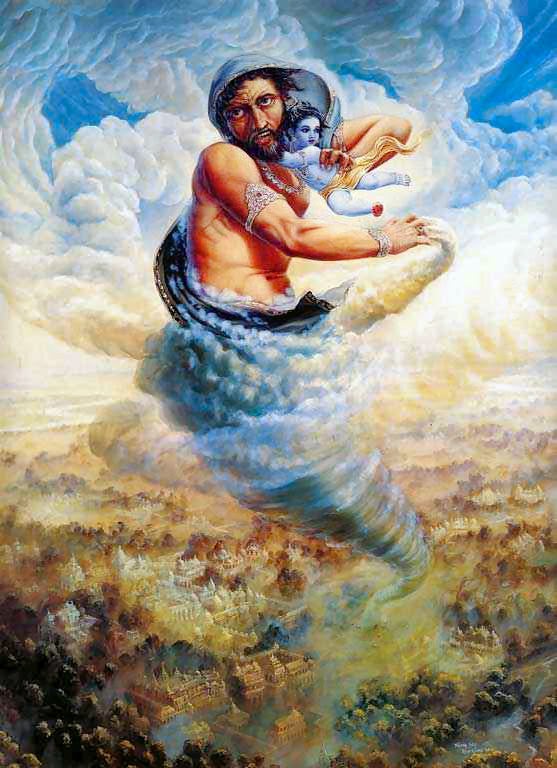
Trinavarta kidnapped baby Krishna, and spun him high into the sky. Trinavarta flew higher and higher up into the sky so that he could drop down Lord Krishna and kill him. Krishna made himself unbearably heavy for Trinavarta too that suddenly he could not go any further, and he had to stop his whirlwind activities. Baby Krishna made Himself heavy and began to weigh down the demon. The Lord caught hold of his neck. Trinavarta felt the baby to be as heavy as a big mountain, and he tried to get out of His clutches, but he was unable to do so, and his eyes popped out from their sockets. Crying very fiercely, he fell down to the ground of Vrindavan and died. He hit the stone ground, and his limbs were smashed to pieces by the transcendent baby Krishna, who emerged without a scratch. His body became visible to all the inhabitants of Vrindavan.
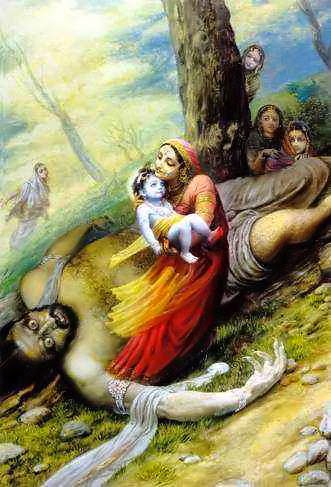
Source: http://krishnaseva.blogspot.in/2014/09/killing-of-demon-dhenukasura-in-talavana.html
When Krishna and Balarama entered sixth year of their ages, they got the permission to take the cattles out for grazing. Along with their fellow cowherds the two brothers too began to take their cattle to Vrindavana. Thus they sanctified the earth of Vrindavana with their pious feet. Seeing the beauty of Vrindavana, with beautiful, colourful flowers and sweet fruits, Lord Krishna felt overjoyed. He then used to graze his cattles at the foothills of Govardhan and on the banks of Yamuna River. Playing flute was his favourite pass time.
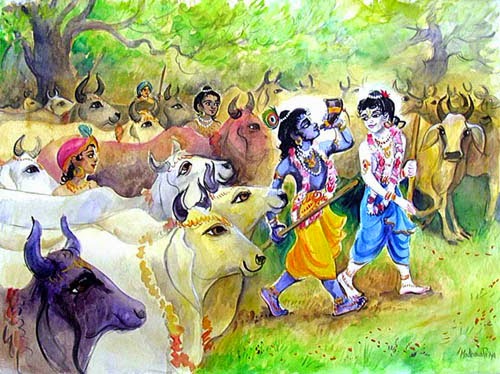
One day one of the Krishna's beloved friend said: Kanhaiya, there is a beautiful forest name Talvana. It has uncountable numbers of trees laden with ripe fruits. But a formidable demon Dhenukasura guards that forest, He is very strong. So no one, even animals and birds, doesn't go there. But we are tempted to eat those sweet delicious fruits. If you and Daau (Balarama) wish, we may go there and eat those delicious fruits."
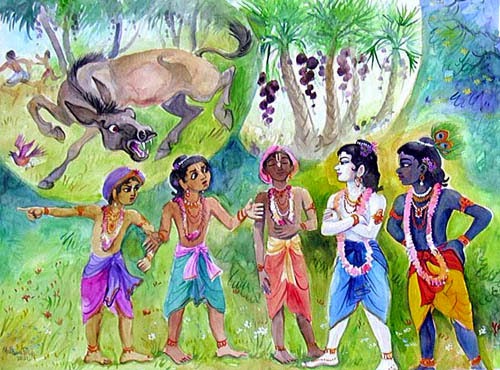
Thus hearing this, Krishna and Balarama guided all of them to Talvana. There they shook the trees and in no time a heap of ripe, delicious fruits gathered under the trees. All the cowherds began to eat fruits. While eating, they were also making lot of noises.
Disturbed by the sound of fruits falling and noise of the cowherds, the demon Dhenukasura arrived there by assuming a form of donkey to hide his real identity and confuse Krishna, Balram and his friends. He was braying loudly and tried to hit Balarama, but Balrama caught him by his hind legs and threw him in the air over the palm trees. The demon died in an instance. Because of the dead bodies of the asses, there was a panoramic scene. It appeared as if clouds of various colors were assembled in the trees.
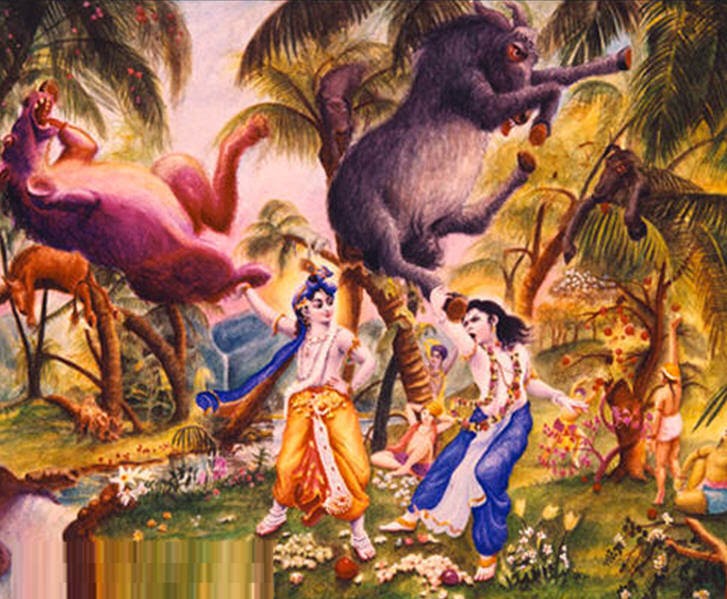
Hearing of this great incident, the demigods from the higher planets began to shower flowers on Krsna and Balarama and began to beat their drums and offer devotional prayers.
A few days after the killing of Dhenukasura, people began to come into the Talavana forest to collect the fruits, and animals began to return without fear to feed on the nice grasses grown there. Just by chanting or hearing these transcendental activities and pastimes of the brothers Krsna and Balarama, one can amass pious activities.
Also read story of Shri Krishna taking up Govardhan Hill and crushing ego of Indra:
http://krishnaseva.blogspot.in/2014/09/shri-krishna-taking-up-govardhan-hill.html
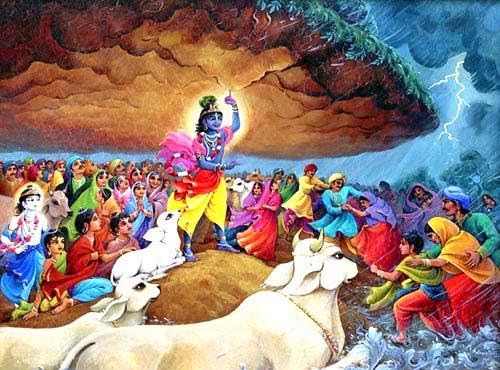
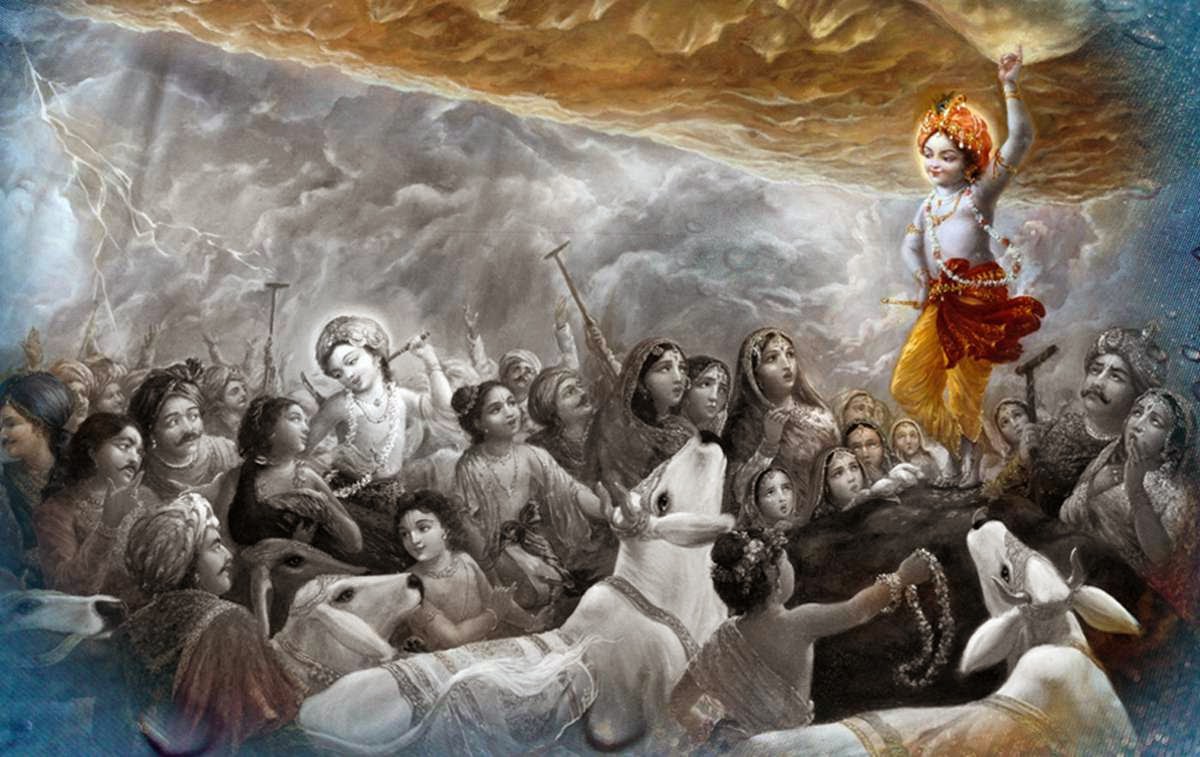
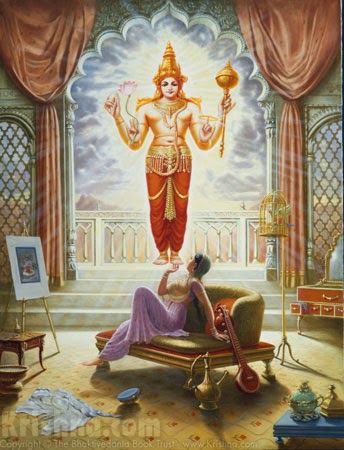


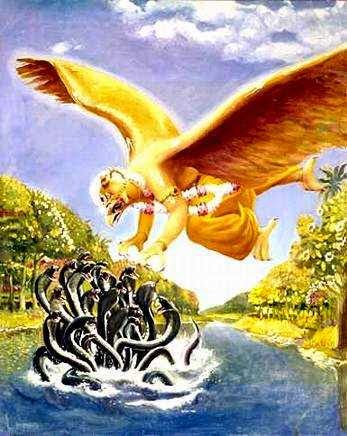
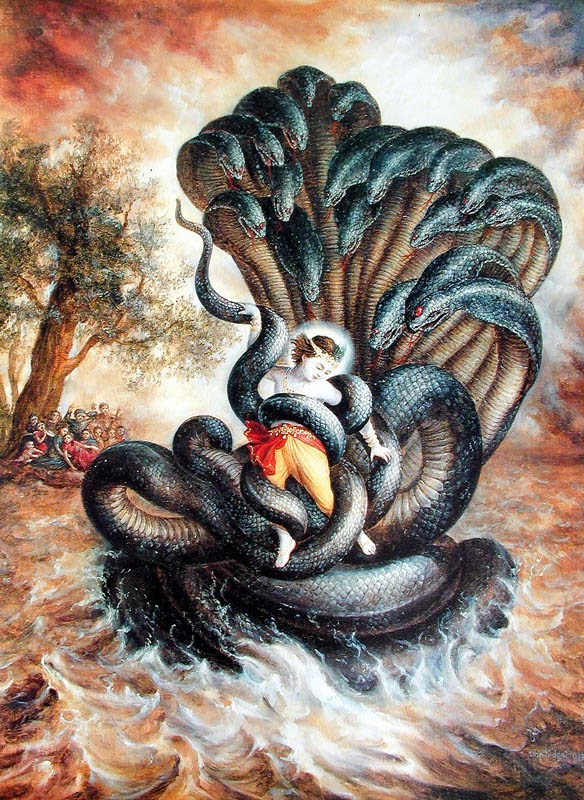
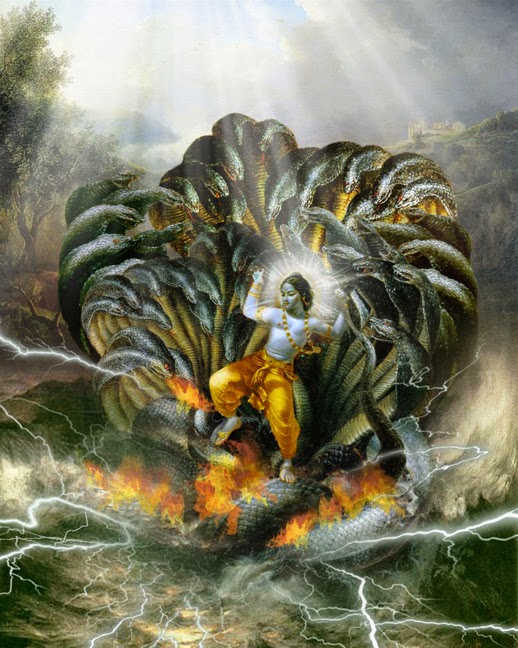
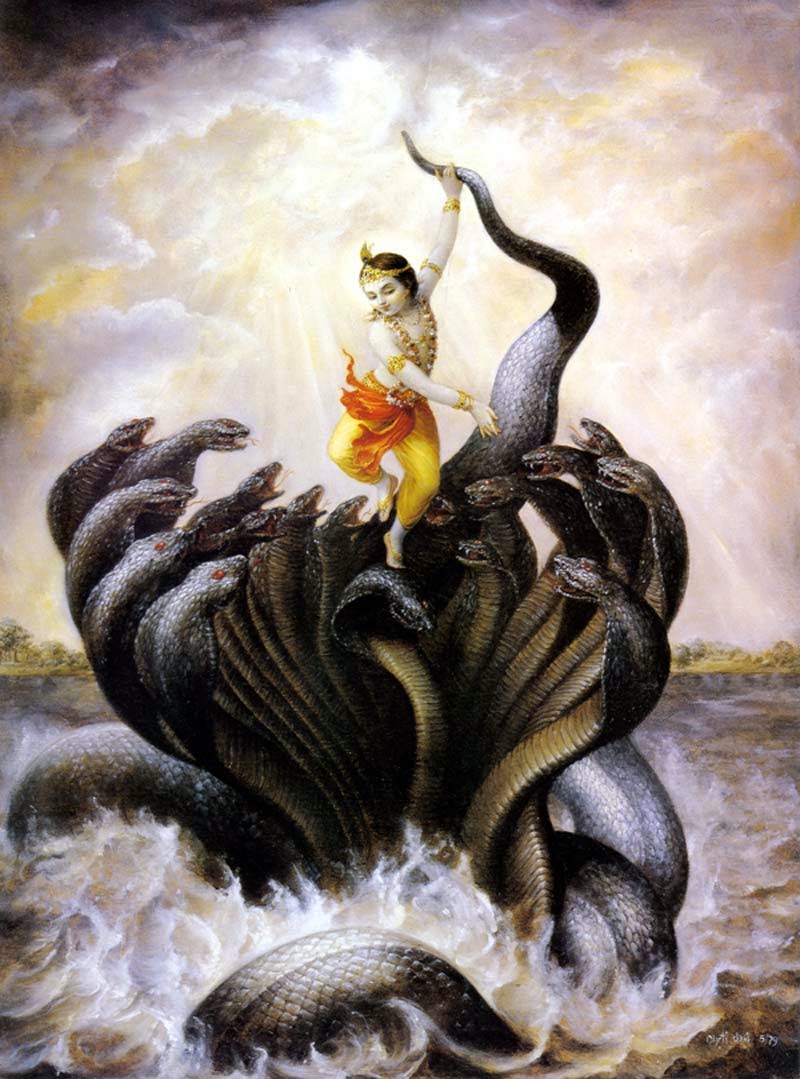
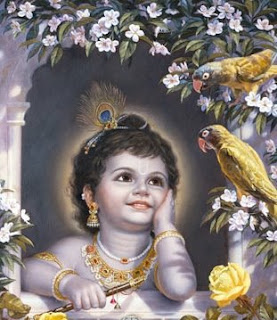
Once Krishna was happily playing in his home. Just then, he heard at a distance, a fruit seller’s voice. She was trying to sell her fruits. She called, “Juicy fruits, buy juicy fruits.” Little Krishna’s mouth started watering at the thought of those nice juicy fruits. He looked around in the house to see what he could find in exchange. He had seen His parents bartering grains for other goods. He grabbed a handful of grains from the house and ran towards the fruit seller. His tiny hands could hold only a little. In a hurry, he also dropped half of the grains on the floor. By the time he reached the fruit seller, he just had a few gains left. He offered those to the fruit seller and said " Could you please give me those mouth watering fruits from your basket in exchange of this?" After requesting, baby Krishna showed the grains that he had in his hand.
The fruit seller was filled with love with the child’s innocence. She was so charmed upon seeing the beautiful form of little Gopal with little hands carrying few grains in exchange of fruits. Even though she was very poor, she happily took the grains from Krishna and gave him as many fruits that his tiny hands could hold. Gopal was very happy and He smiled at her. With a smile and satisfaction on her face and basket on top of her head, she walked towards her home.
Little did she know that there was a huge surprise waiting for her. As soon as she took the basket off the head and put it down on the floor, she could not believe her eyes at what she saw. All the little pieces of grain that Krishna had given her had turned into valuable pieces of jewels that filled her basket.

This is Bhakti. Krishna doesn’t care about what we have done or who we are, because ultimately we are all eternal souls. If we simply offer a little love to Lord Krishna, He reciprocates with an ocean of infinite love. If we take one sincere step towards Krishna, Krishna is willing to run thousands of steps towards us. He just wants to see our sincerity.
Also read about Kaliya Daman lila of Shri Krishna:
http://krishnaseva.blogspot.in/2014/08/krishna-leela-kaliya-daman.html
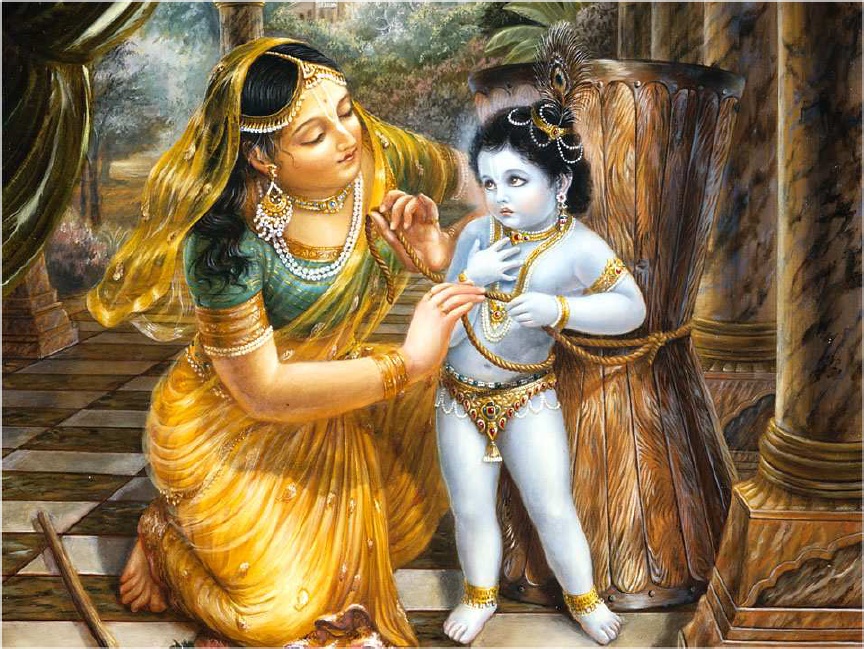
After tying Krishna With Mortar (Ukhal) Yashoda set about doing some household job. Krishna sat down on his knees and caused the mortar to tumble down so that it could roll when drawn. Now he began to crawl on his knees towards the twin trees standing in front of the house.The twin trees were, in fact, the two sons of Kubera--the god of wealth. Their names were Nalkuber and Manigreev. It was because of a curse that they had been turned to trees. The story goes that once these two brothers, after taking wine, were having their bath in the company of their wives. All of a sudden, Saint Narda happened to come there. Seeing him, both the ladies put on their clothes and got aside. But both the brothers, intoxicated as they were, kept standing naked before the saint. The saint could not tolerate their impertinence and uttered a curse on them," Go and stand as trees in Gokul for ever."
Hearing the curse, the wives of both the brothers got worried and they beseeched the saint to excuse their husbands. The saint replied, "They will be rid of this curse when Shri Krishna will appear in Gokul". Since the curse was uttered these trees had been standing in front of Nand Baba's house. So, to keep up the word given by Saint Narda to the wives of the two brothers, Krishna dragged the mortar crawling in between the trees. The mortar got stuck up between them and when Krishna exerted force, the trees got uprooted and fell down. As soon as the trees fell down, they changed into their real forms as sons of Kubera. With folded hands, they began to praise Krishna and after seeking his permission, they returned to their place. 
Nand Baba and Yashoda came out running. They untied their son Krishna and fondled him time and again whereupon Krishna began to smile.
Note: Damodar means "One who has rope around his belly'. Dam - Rope, Udar - Stomach/Belly
Also read about other Krishna Leela - His mercy on poor fruit seller:
http://krishnaseva.blogspot.in/2014/08/lord-krishnas-mercy-on-poor-fruit-seller.html



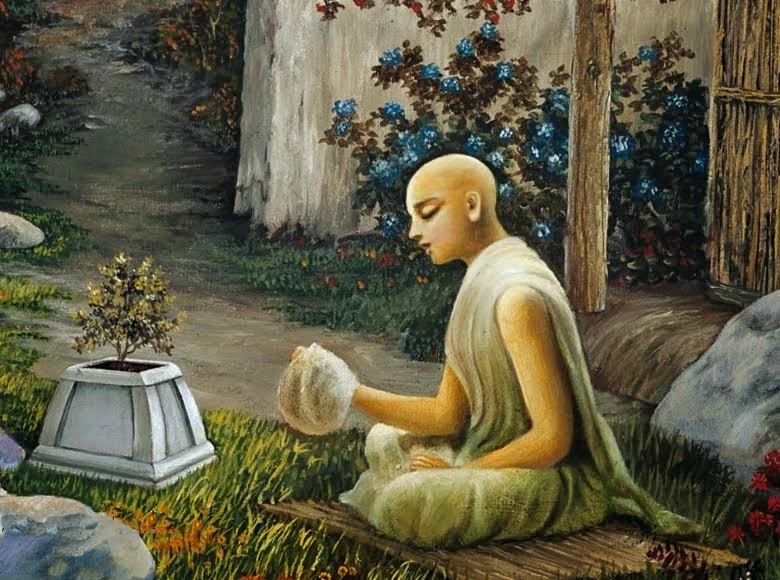




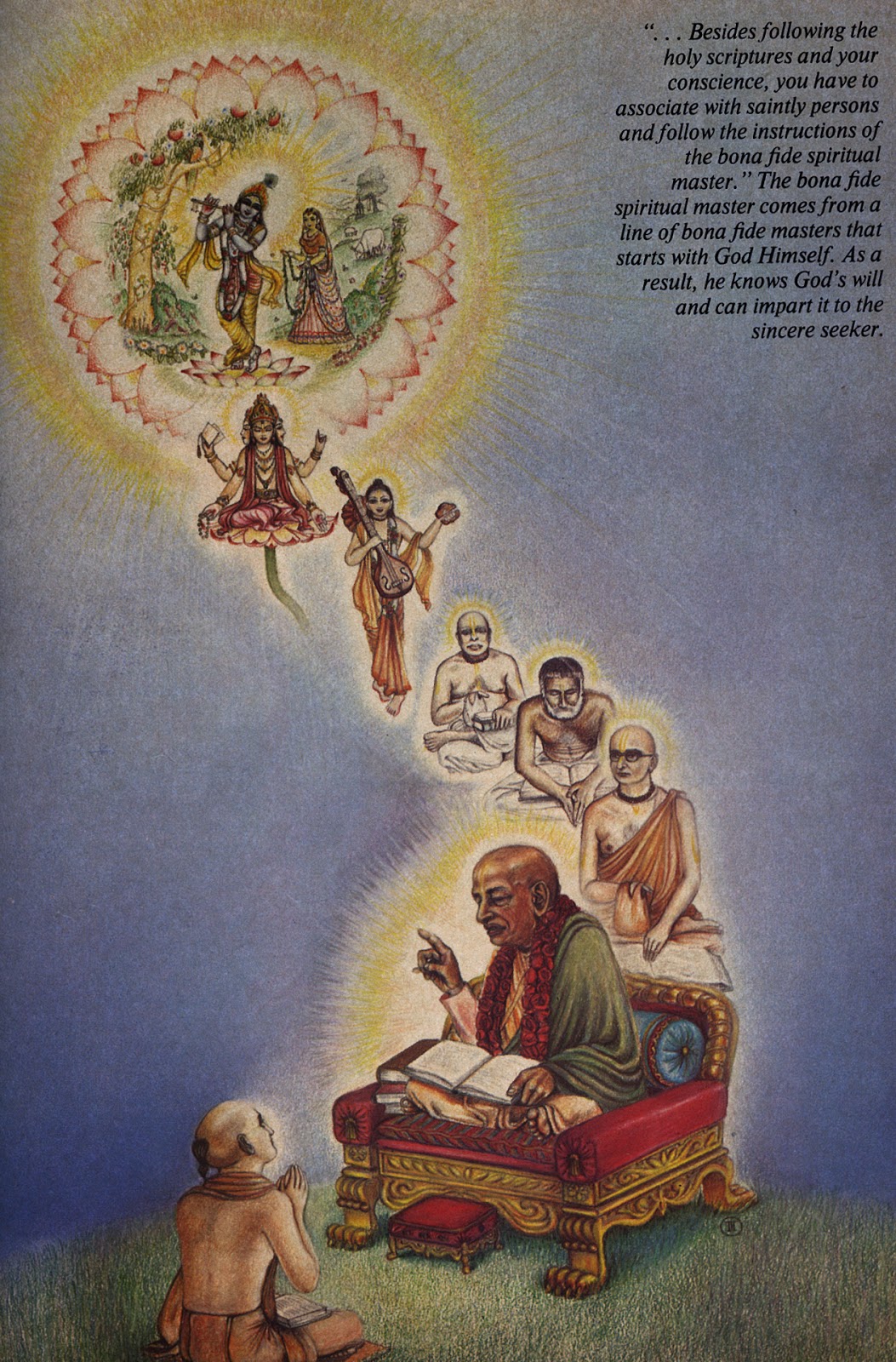
Source of this post:
http://krishnaseva.blogspot.com/2014/05/prayer-bhajan-jai-radha-madhav-in.html
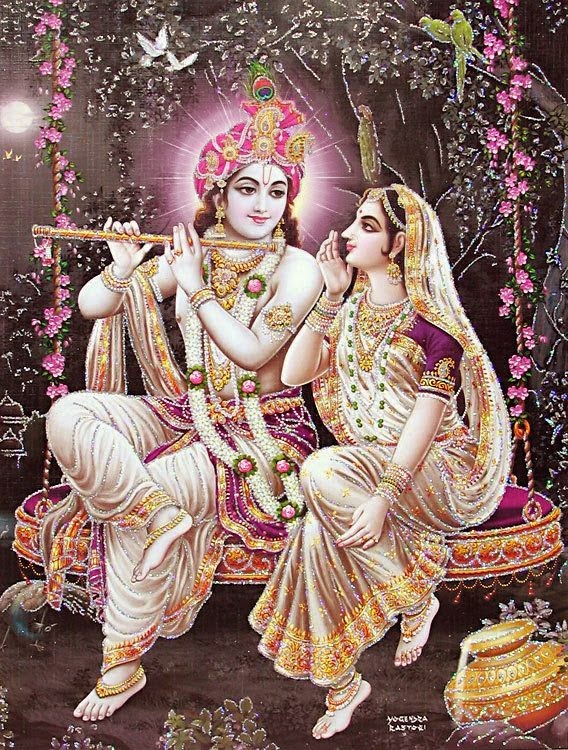
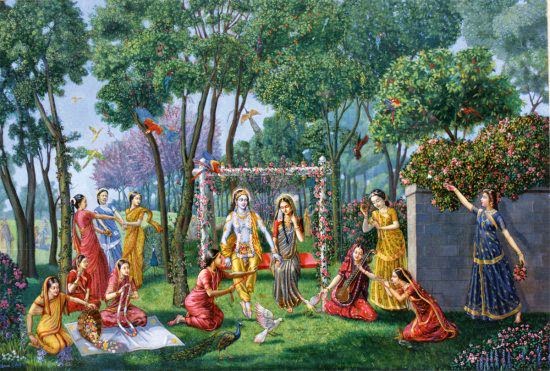

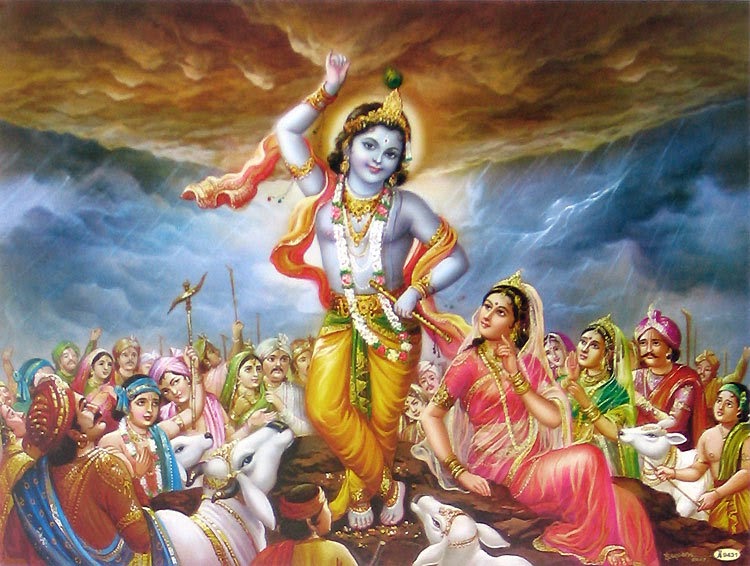


For more such Bhajans, please visit:
http://krishnaseva.blogspot.com/
Your servant,
RadheKrishna Das

